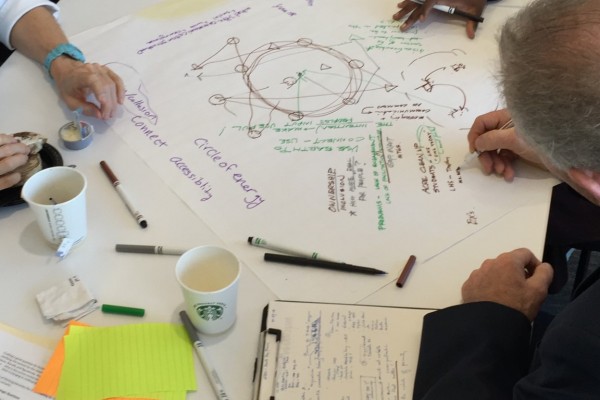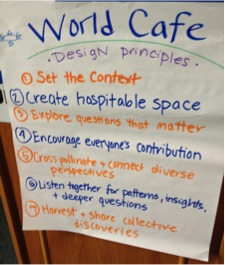One of the biggest challenges is that organizations and larger systems are siloed: people work in the same organization/community/system or on the same issue, yet they don’t talk to each other or understand how their work or issues relate. The World Café conversational method enables people from these “fragmented” parts of a community/system to meet and get to know each other and deepen their understanding of other  parts of the system/issue. I’ve facilitated it with groups of about 12 people to over 200 people.
parts of the system/issue. I’ve facilitated it with groups of about 12 people to over 200 people.
People are invited to into small groups of four; this can be on-line or in person. The first round of conversation they answer a question and have about 20-25 minutes to discuss a question. Then one person stays at that table and everyone else moves to a new table.
The next round of conversation begins with people sharing highlights from the previous one, so across the room there is a cross-pollinating of many conversations. Then they can explore a new question. Setting the context and framing effective questions are key to this working well. This blog, Setting the Table for a Great Meeting, offers a process for getting clear on a narrative and framing a compelling question to explore. This creates a container and shared purpose for the conversation.
Conversations are what connect across siloes. The World Café process is valuable for how it can create many other benefits:
- Build a foundation of trust for collaboration– Establishing relationships and building trust are foundations of building interest and willingness of people to collaborate from various departments, organizations, or parts of a community. Building a relationship starts in conversation – in talking and listening. The small group format of World Café offers the space for deeper conversations and storytelling. The mixing of rounds increases the number of people who connect. A conference participant at a World Café I hosted at a socially responsible business conference enthusiastically shared with me, “I got to meet and really talk with nine people. The connections were much deeper than a typical conference where you chat at the coffee break or lunch.”
- A taste of collaboration’s benefits – Participants get to experience a small taste of emergence, one of the benefits of collaboration, where my idea can combine with your idea
 to create something new. In this video, about Where Good Ideas Come From, Stephen Johnson shares his insights from studying history that times of great innovation happened in places where ideas and people could cross-pollinate in café-style spaces.
to create something new. In this video, about Where Good Ideas Come From, Stephen Johnson shares his insights from studying history that times of great innovation happened in places where ideas and people could cross-pollinate in café-style spaces. - Planting seeds – You never know where the seeds from any one of the many conversations and new connections will take root. For example, in December, I facilitated a World Café and Open Space at a leadership conference for non-profits and foundations in Greater New Bedford. The following June, I learned that three groups were still meeting, continuing conversations that got started that day.
- A different way of learning – Often we think of education and learning in the model of a teacher or expert at the front of a room sharing information to an audience of students, e.g., Powerpoint slide shows. The World Café offers a way to practice collective learning, surfacing and synthesizing the collective experience of people in the room to gain new insight, while also providing a way for each individual to learn and make unique connections relevant to their work. Learning comes from having the space to reflect on one’s experience and hear about others. Examples of World Café questions for collective learning are:
- When has collaboration happened in this organization that went well? What were the conditions that enabled this?
- What have we learned from this experience?
